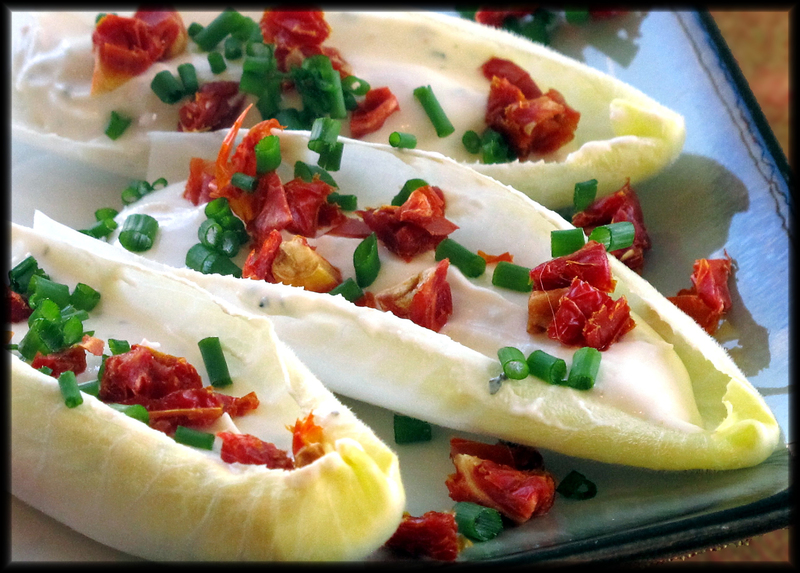What do you call that compact, slender head of green-edged, pale-colored lettuce? About six inches long, it looks somewhat like a torpedo in shape, with a flat, white base and tightly furled leaves. The grocery bins usually have two or three specimens available for sale. Is it called “n-dive” or “on-deev”?
Linguists will tell you either pronunciation is correct, while members of the California Endive Farm call for a different pronunciation based on which specific variety. All are members of the chicory family, but the similarities end there. Loose-leafed, dark green, wild-looking bunches (also known as curly endive, escarole or frisée) are pronounced n-dive.
The other variety, sometimes called Belgian endive, is the well-groomed cousin of these disheveled lettuces and is pronounced on-deev, according to the folks in California. In keeping with its appearance and subtle flavor, the cultivation of Belgian endive is a complex process. Seeds of the appropriate variety of blue-flowering chicory plants are sown in the spring and develop three-foot-tall foliage by autumn.
In the next step in the growing cycle, the foliage is mowed down and only the roots are harvested. The roots are then placed in an environment similar to that designed for mushroom production. Row after row of containers are filled with roots that will be kept in this dark, moist place for about one month.
Each of the chicory roots, topped with a single bud, produces one mature endive. Their pale color is the result of the cellar-like conditions - no sunlight, no photosynthesis, no green leaves. The tasty endive is cut from its root and shipped to market. And, since the process is so well-controlled, we can enjoy endive all year.
How (or maybe why) was this process developed? Chicory plants were historically cultivated for their roots. These were dried and ground, then brewed into a dark, bitter beverage sometimes used as a coffee substitute. According to culinary lore, a Belgian farmer of the early 1800s left for war, leaving behind his harvested crop of chicory roots in a cool, dark cellar. When he returned, he found the roots had sprouted, producing small heads of tender, white-leafed lettuce.
This surprise crop had a crisp texture and slightly bitter snap, perfect for tossing into salads. Braising endive in stews or sautés will soften and sweeten its flavor. Most of you have likely encountered endive served as an appetizer in the form of a “boat” to hold cheese, vegetables, nuts and other tasty ingredients (see photo).
Since endive is not grown in soil and is handled under sanitary conditions, you shouldn’t need to wash the leaves (I always rinse or discard the outer few, just to be safe). Trim off the flat bottom and separate the leaves, tugging from the base to avoid tearing their tender tops. Remove the small core when serving endive raw; leave it in the mix for cooked dishes.
The recipe for stuffed endive in the photo is the result of a mix-and-match process. First, select a creamy cheese such as a log of peppered goat cheese or crumbled blue mixed with a bit of sour cream. Place a dollop of cheese in each leaf and top with chopped bits of sweet or savory ingredients.
Consider dried apricots or cherries for the sweet; choose sundried tomatoes or smoked salmon for savory. Finally, dust them with chopped nuts or snipped herbs. I prefer not to drizzle these with a dressing, to make them easier to offer as tidy finger foods.
I’ve included recipes for a few of my favorite ways to serve endive, from sweet to savory to filled with rich flavor. Feel free to select whichever pronunciation you prefer.
Oven Braised Endive
4 heads endive
1 t olive oil
salt & white pepper, to taste
1 C vegetable broth
Preheat oven to 350 F. Coat the inside of a small baking dish with nonstick cooking spray; set aside. Cut endives in half lengthwise.
Heat oil in a skillet over medium low. Place endives in the pan, cut side down. Cook until edges have begun to brown, about 5 minutes.
Turn endives and cook another 5 minutes. Remove endives to prepared baking dish, arrange them in a single layer, cut side up. Dust with salt and white pepper.
Pour in broth and bake for about 1 hour, basting occasionally. Yield: 4 servings.
Sweet Endive Skillet
4 heads endive
2 T butter
juice and zest of one orange
2 T balsamic vinegar
1 T maple syrup
pinch of salt
1 t chopped parsley
Cut endives in half lengthwise. Melt butter in a skillet over medium. Add endives, cut side down, and sauté for 5 minutes. Turn endives and sauté for another 5 minutes. Whisk together remaining ingredients and pour over endives. Reduce heat to low, cover and simmer for 30 minutes. Yield: 4 servings.
Easy Endive Boats
2 heads endive
5 oz package Boursin cheese*
2 T sour cream
2/3 C chopped sun-dried tomatoes
1/4 C snipped chives
pepper, if desired
Trim the stem from the endives and separate the leaves, discarding any that are discolored. Arrange the leaves in a single layer on a serving platter; set aside. Combine the sour cream and Boursin in a small bowl, whipping until light and fluffy. Place a small dollop of cheese mixture at the base of each endive leaf, spreading slightly. Sprinkle generously with tomatoes and chives. If desired, grind pepper over the platter. *Note: these are available in a variety of flavors; choose combination. Yield: approximately 2 dozen pieces.























































